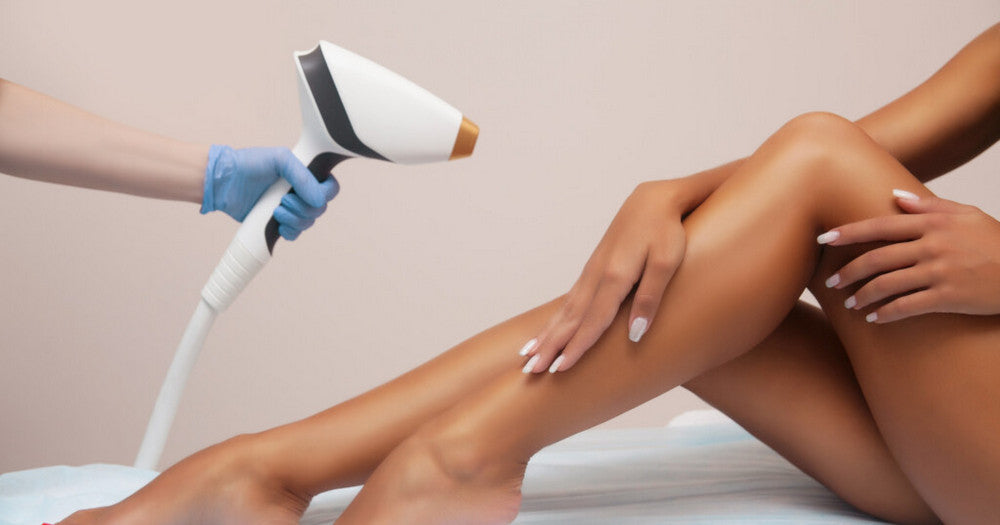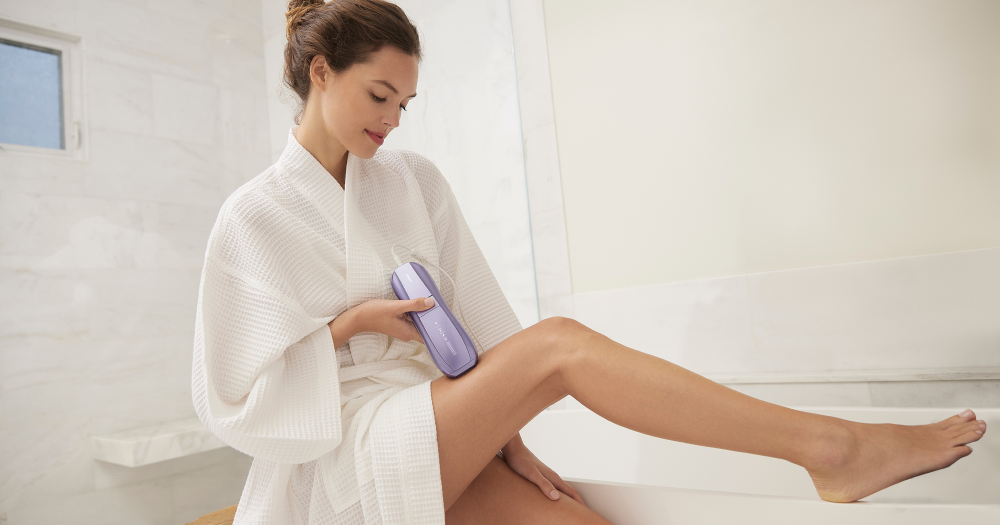Laser hair removal is considered the solution for all hair problems such as ingrown hairs, hirsutism, rapid hair regrowth, Strawberry legs and more. However, in rare cases it also causes hair follicle diseases. This disease is called folliculitis, an inflammation of the hair follicles.
Although the link between folliculitis and laser hair removal is poorly researched, there is some evidence that folliculitis may be triggered by laser hair removal.
Therefore, in this informative article, we will talk about this unusual phenomenon and discuss the context, causes, prevention and treatment of folliculitis after laser hair removal treatment.

- Part 1: Why do I get folliculitis after laser hair removal?
- Part 2: How to treat folliculitis after laser hair removal?
- Part 3: When should you seek medical attention for folliculitis after laser hair removal?
- Part 4: How to prevent folliculitis after laser hair removal?
- Part 5: Conclusion
Why do I get folliculitis after laser hair removal?
Contrary to what you might think, folliculitis can occur after laser hair removal. Here's how it happens.
Folliculitis:
Folliculitis, as the name suggests, is an inflammation of the hair follicles that presents itself as small red bumps on the skin that may or may not be tender. Additionally, pus may come out of the follicle. Folliculitis must be differentiated from other similar bumps on the skin such as ingrown hairs and herpes.
It is caused by the hair follicles becoming blocked by dirt, impurities or bacteria.
Folliculitis and laser hair removal:
Logically, laser hair removal is considered a procedure that kills the hair follicles. However, it is also a procedure that leads to folliculitis as a complication. To understand this procedure, let's first look at how folliculitis occurs.
Folliculitis is caused by an inflammatory reaction to a foreign body, a microorganism or something that the skin does not recognize. In this case, the hair falls out and is perceived by the skin as a foreign body.
This causes inflammation and folliculitis develops.

Causes of folliculitis after laser hair removal:
Folliculitis during laser hair removal is caused by:
- Heat: The laser beam is converted into heat at the level of the hair follicle. It is quite natural that this heat causes inflammation and swelling in the tissue. Therefore, one of the main causes of folliculitis after laser hair removal is uncontrolled exposure to heat.
- Microbes: Microorganisms such as bacteria, yeasts and viruses can also cause folliculitis. They penetrate the skin and trigger an inflammatory reaction in the hair follicles. The most common organism involved in this process is Staphylococcus, as it lives on the skin.
- Contaminants: Just as bacteria can cause inflammation, contaminants such as dust and sweat do the same.
- Foreign body reaction: If there are no other causes, the falling hair acts like a foreign body, activating the immune system and causing folliculitis.
Risk factors for folliculitis after laser hair removal:
Conditions that make the skin more susceptible to folliculitis include:
- Coarse hair: Coarse hair tends to curl back into the skin. This curling of hair causes bumps called folliculitis. It is also more common in people with curly body hair than those with straight hair.
- Dark hair: Just like coarse hair, dark hair also causes folliculitis. In particular, the emergence of dark hair from the follicles makes the skin susceptible to folliculitis.
- Skin irritation after laser treatment: Skin irritation caused by tight clothing, harsh chemicals or heat increases the risk of folliculitis.
- Damaged skin barrier: And last but not least, if you do not take proper care of your skin before and after laser hair removal, you are likely to get bumps on your skin.
How to treat folliculitis after laser hair removal?
Folliculitis can heal on its own once the hair shaft is completely shed from the skin, but you can use topical and systemic treatments to speed up this process.

Topical treatments:
Topical treatments are useful in mild to moderate cases.
- Antibacterial creams: Topical antibacterial creams such as neomycin, clindamycin and mupirocin are effective in treating folliculitis.
- Steroids: Hydrocortisone creams reduce inflammation and therefore the severity of folliculitis.
- Fluocinonide creams: It is a corticosteroid that works similarly to hydrocortisone to treat folliculitis.
- Antiseptic wash: Keeping the skin clean is an important step in treatment. Use an antiseptic body wash for this purpose.
Oral treatments:
If the inflammation is severe and topical treatment is not effective, you should consider taking systemic medications.
- NSAIDs: If the bumps are red and tender, NSAIDs can help relieve the pain and inflammation.
- Antibiotics: Oral antibiotics such as doxycycline, flucloxacillin and fusidic acid can be used in the treatment of folliculitis.
- Anti-fungal medication: If there is a possibility that your skin has contracted a fungus, take fluconazole to treat it.
When should you seek medical attention for folliculitis after laser hair removal?
Home remedies and simple measures can help treat folliculitis. Sometimes the cause may be unclear, which makes treatment complicated. In such cases, it is better to talk to a doctor about your condition rather than prescribing something yourself.
You should also consult an expert in the following cases:
- Delicate bumps that are very painful
- Uncontrollable itching
- Increasing number of inflamed follicles
- Water or pus discharge from the follicles
- Fever
- Skin rashes
- Systemic signs of infection
How to prevent folliculitis after laser hair removal?
As mentioned above, folliculitis itself is a rare disease. To minimize the chances of developing folliculitis, here are some tips for you.
Reputable laser provider:
When you decide to undergo a treatment, always pay attention to the qualifications, skills and reviews of the laser provider. A well-trained professional will take all the necessary measures to ensure that you receive the treatment with minimal side effects.
Maintaining hygiene:
First of all, you should prevent bacteria and contaminants from entering the hair follicle without irritating the skin. So, use a gentle antimicrobial cleanser to thoroughly clean the treatment area after laser hair removal. You can also apply compact moisturizers to strengthen the skin barrier and prevent folliculitis.
Avoid sun and heat:
Inflammation is another major cause of folliculitis after laser hair removal. Heat stimulates inflammation and worsens its effects on hair follicles. Therefore, avoid hot showers, steam, saunas and even exercises that make you sweat for 2 days after treatment. Instead, keep your body cool.

In addition, the heat and UV rays from the sun can sensitize the skin, so you should protect your skin from the sun by staying indoors and applying sunscreen.
No tight clothes:
Tight clothing comes into contact with the skin and causes constant friction. It also prevents ventilation and traps moisture. All of these effects lead to folliculitis. Therefore, wear light and loose clothing that provides enough ventilation to allow your skin to heal.
Natural fabrics like cotton, silk and linen are better than polyester and nylon.
No products containing chemicals:
To prevent folliculitis, you must avoid using products that may irritate the skin. Products you should avoid include retinol, AHA, BHA, perfumes, fake tanners and deodorants.
Follow the instructions of your treating expert:
After laser hair removal, the expert will prescribe the appropriate treatments depending on the condition of your skin and your body's reaction to the laser. He will also give instructions for aftercare. As long as you follow the instructions, you can prevent folliculitis.
Conclusion
Folliculitis after laser hair removal is the result of incomplete detachment of the hair strand, entry of bacteria, and clogging of the follicle by dirt. Although the appearance of red bumps on your skin after the treatment may seem alarming, it is not a big deal as it can be easily prevented and treated.
Therefore, we have discussed prevention, which is mainly based on pre- and post-operative care, and treatment with topical and systemic anti-inflammatory and antimicrobial agents above.
Finally, it is recommended that you see your doctor if you develop signs of severe folliculitis.





























1 comment
Melissa
I started the treatment with IPL machine at home a week ago and by the end of the week after 3 sessions I started seeing red bumps that are very itchy. A week has passed and they’re still there, i did another session yesterday and the bums are still there. I’ve been treating them with cortisone. Any suggestions on the use of the Ulike after experiencing this?
I started the treatment with IPL machine at home a week ago and by the end of the week after 3 sessions I started seeing red bumps that are very itchy. A week has passed and they’re still there, i did another session yesterday and the bums are still there. I’ve been treating them with cortisone. Any suggestions on the use of the Ulike after experiencing this?